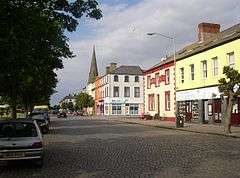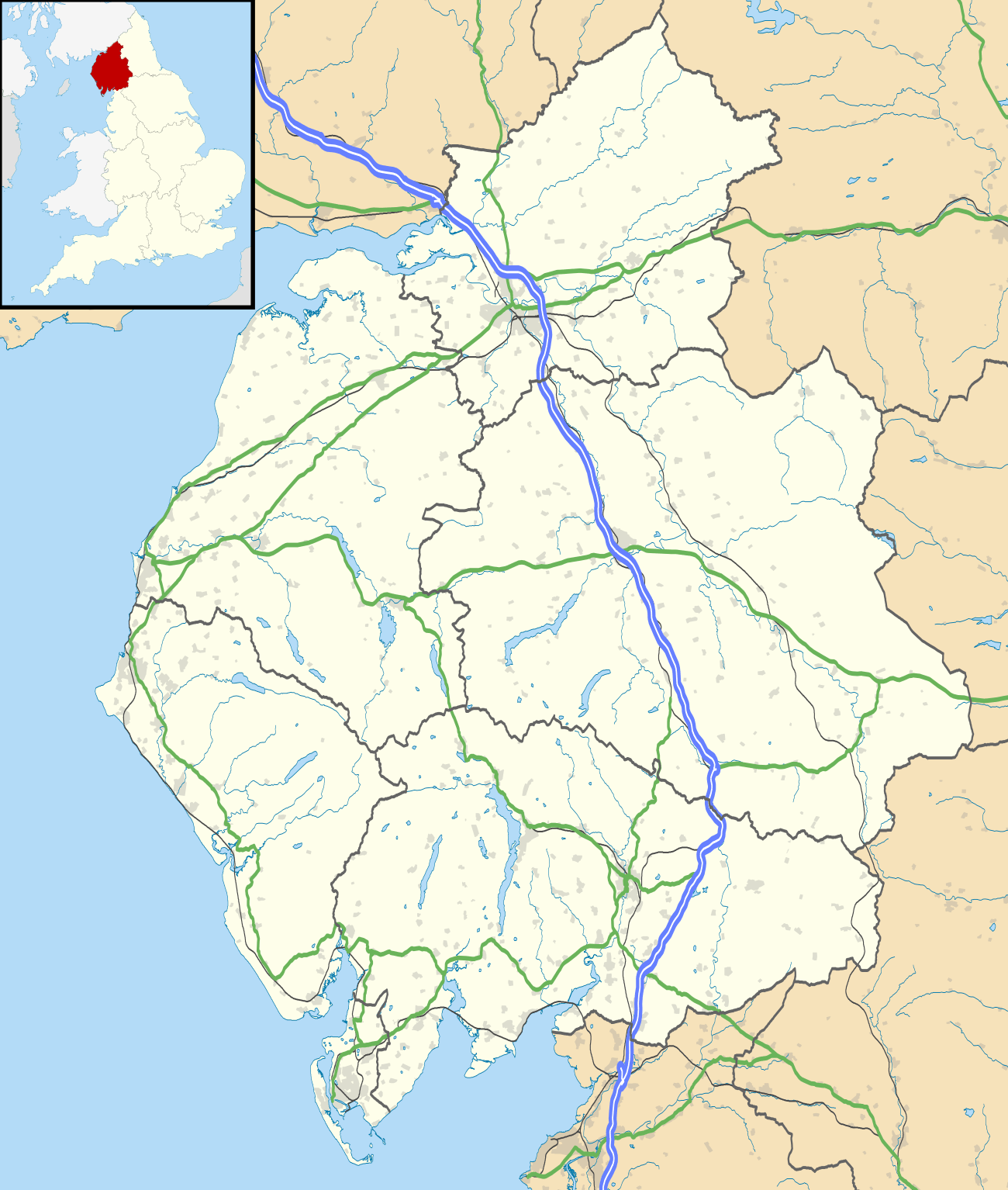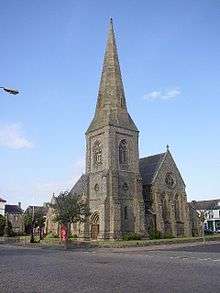Silloth
Silloth
| |
|---|---|
 Criffel Street, Silloth | |
 Silloth Silloth shown within Cumbria | |
| Population | 2,906 (2011) |
| OS grid reference | NY113536 |
| Civil parish |
|
| District | |
| Shire county | |
| Region | |
| Country | England |
| Sovereign state | United Kingdom |
| Post town | WIGTON |
| Postcode district | CA7 |
| Dialling code | 016973 |
| Police | Cumbria |
| Fire | Cumbria |
| Ambulance | North West |
| EU Parliament | North West England |
| UK Parliament | |
Silloth (sometimes known as Silloth-on-Solway) is a port town and civil parish in Cumbria, England. It sits on the shoreline of the Solway Firth, 22 miles (35 km) west of Carlisle. The town of Maryport lies 12 miles (19 km) to the south, down the B5300 coast road which also passes through the villages of Blitterlees, Beckfoot, Mawbray, and Allonby. Wigton is twelve miles to the east, along the B5302 road, which also passes through the village of Abbeytown, 5.5 miles (8.9 km) to the south-east. Silloth had a population of 2,932 at the 2001 Census,[1] reducing slightly to 2,906 at the 2011 Census.[2]
Historically a part of Cumberland, the town is an example of a Victorian seaside resort in the North of England. Silloth developed in the 1860s onwards around the terminus of the railway from Carlisle and associated docks which had begun construction in 1855 to replace Port Carlisle as the deep-water port for Carlisle.
For the first time workers from the factories of Carlisle were presented with affordable access to the seaside, and the town flourished as a destination for day trippers. The town reached the peak of its popularity in the late 19th and early 20th centuries. Recent years have seen a great deal of development: many of the sea-facing properties have had facelifts. The main central attraction is a large expansive green that is used throughout the year for various events and activities.
Etymology
'Silloth' means "'sea barn(s)', v. 'sǣ hlaða'."[3] (The first word is Old English, the second is Old Norse).
Governance
An electoral ward in the same name exists. This ward stretches north and inland with a total population at the 2011 Census of 3,268.[4] There is an active parish council, known as the town council.
Churches

Silloth's largest church is Christ Church, situated in a complete rectangular plot which was planned into the original town design. It is on a commanding site at Criffel Street and the body of the church was completed in 1870.[5] The porch tower and large broach spire were completed later in 1878, and house a ring of 8 bells which are chimed. It was designed by Carlisle architect Charles John Ferguson in the Gothic style, and is built with an interesting mix of local sandstone, and granite which was brought by the North British Railway from Newry in Northern Ireland. Much of the interior is faced with yellow brick trimmed with red. [6]
Several other churches and chapels of various denominations are also located within the town or its outskirts.
Industry

Port of Silloth
One of the busiest ports in Cumbria, Silloth is owned and operated by Associated British Ports. The main cargoes are wheat, fertiliser, molasses, forest products and general cargo.[7]
Carrs Flour Mill
An example of a Victorian flour mill, the building was constructed adjacent to the New Dock in 1887. Carr's flour mill is an operating mill which supplies flour to a number of food manufacturers such as United Biscuits,[8] Warburton's Bread and several other leading bakeries and confectioners.
Agriculture
Farming of livestock, mainly sheep, beef and dairy cattle, takes up most of the surrounding landscape.
Tourism
There are a number of static and touring caravan and camping parks in the town and surrounding area.
The town has a small brewery which produces traditional ales for the guest beer market. It recreates traditional ales brewed to the original recipes. A range of 20 beers are produced; some are available in the Albion and Silloth Social Club.
Many small businesses can also be found located on the former Second World War airfield and associated buildings.
Notable people
Born in Silloth in 1903, Jim Brough played rugby union for Silloth and England. He played in the Cumberland side that won the county championship in 1924 and made his international debut against New Zealand in January 1925. He switched codes and played rugby league for Leeds and Great Britain, captaining the national side in 1936. As a coach, he took Workington Town to two finals in 1955 and 1958 before coaching the Great Britain touring team, which became the most successful touring side and the only touring team to score over 1,000 points. In 2005, Silloth RUFC renamed their ground in his honour.
Charlotte Cecilia Pitcairn Leitch
Cecil Leitch was born in Silloth in 1891. Self-taught golfer, she won four British Ladies amateurs between 1914 and 1926. In total she won 12 national titles, 5 French Amateur Ladies and one Canadian Women's Amateur before retiring in 1927. During her playing career, she was one of the leading ladies in the sport and transformed the way that the game was played by women.
Flying Officer Albert Bosward DFC
Albert Bosward became a Commissioned Pilot Officer in 1942 and was promoted to Flying Officer on 17 October 1943. He flew 4 engine Lancasters with 9 Squadron and took part in a number of raids over Germany and France. On 11/12 September 1944, the squadron went to Archangel in Russia in order to attack the German battleship Tirpitz which was sheltering in a Norwegian fjord. Bosward took part in the raids in which the battleship was damaged but not sunk. It was later sunk by the RAF on 12 November 1944. He was awarded the Distinguished Flying Cross (DFC) on 14 November 1944 for his part in the Tirpitz raid.
Jimmy "Pongo" Wareing
Jimmy Wareing was born in Silloth in 1917 and played rugby union for Silloth and Cumberland before the war. He served in the British Army during the Second World War and was evacuated from Dunkirk on the SS Manxman. In 1943, he graduated from Sandhurst as a lieutenant and joined the Buffs to command a group of flame throwing tanks which took part in the Allied advance from Caen to Calais. In September 1946, he joined Workington Town rugby league team playing 189 games for the team and scoring 20 tries and 14 goals. Wareing appeared at Wembley in 1952 when Workington Town beat Featherstone Rovers in the Challenge Cup final. He also played in the Championship final of 1951 when Town beat Warrington 26-11.
Kathleen Ferrier, a contralto singer, shot to fame while living in Silloth and performing in Cumberland. She died in 1953 at the age of 41 and Granta magazine wrote at the time that she “may well have been the most celebrated woman in Britain after the Queen”. There is now a café known as 'Mrs Willson's' named in honour of this talented woman. This café is located on Criffel Street, overlooking the green.
Tourism

Tourism is a major contributor to the economy in Silloth, with dozens of large and small static and touring caravan parks located within a ten-mile (16 km) radius of the town centre, resulting in a large increase in the population during the summer months. Although a couple of these parks are somewhat self-contained, they still rely heavily on the town for support and infrastructure such as the post office, doctor's surgery, chemist, newsagent's, mini supermarkets, hardware, spares and consumables, cafes, chip shops, sandwich bars and pubs. Historically Silloth has been very popular with tourists from Scotland.
Silloth also hosts several small annual events held on the town green. These include a beer festival[9] held in September, its steam rally, kite and food festivals.
By far the area's largest annual event is Solfest.[10] The Solway Music Festival (Solfest) is Cumbria's biggest four-day live music festival with a maximum attendance in 2008. Located at Tarns, about five miles away, Solfest has been running since 2004 and now regularly attracts crowds of over 10,000 every August bank holiday weekend, with its eclectic mix of music, site art and cabaret performers and the friendly atmosphere which resulted in it winning the "Best Family Friendly Festival" award in the 2007 UK Festival Awards (the only Cumbrian festival ever to win an award). Solfest[11] has also been credited by Cumbria Tourist Board for introducing a younger generation of tourists to Silloth and in doing so has greatly boosted the future of tourism in the town.
Amenities include a championship golf course ranked amongst the country's top fifty courses,[12] several hotels and bed and breakfasts, public houses, tea rooms and eateries. There is a local 'free' newspaper published monthly entitled 'The Solway Buzz' - distributed to households in the area by a team of volunteers - which covers news and events in Silloth and the surrounding area.
Silloth also prides itself on its coastline along the Solway Firth, which has been described in one of the country's leading sea fishing publications, Total Sea Angling, as having the best flatfish fishing coastline in the country, with over 20 miles (32 km) of beach and promenade to choose from. Bait and equipment are also available locally. Wind and kite surfing are also popular along the coast at Allonby, 8 miles (13 km) from Silloth town centre.
Airfield Project
In 2014, Silloth Tourism Action Group (STAG) received a grant of £9,600 from the Heritage Lottery Fund (HLF), to help fund research into both the history of Silloth Airfield and community memories from the war. The airfield opened in June 1939, just before the start of the Second World War, and closed on 31 December 1960. Originally designed to be used by RAF Maintenance Command, 22MU, the airfield was handed over to Coastal Command during November 1939. No 1 Operational Training Unit (OTU) was then responsible for training pilots and crews from the UK and Allied Countries. Therefore, the aerodrome had twin responsibilities, the maintenance and repair of planes for use in the war effort and the training of crews from allied countries to fly planes and help win the war. The HLF project ended in April 2015 with a celebratory evening and the launch of a short documentary film which traced the development of the airfield and its role during the War Years.
Communications
Railway
The railway came to Silloth in 1856, passing through the villages of Kirkbride and Abbeytown to Carlisle. The railway provided quick access to the town for tourists, but was closed as part of the Beeching cuts in 1964.[13]
Road
Silloth is on the B5302 road, which leads to the A596 and the town of Wigton, 12 miles (19 km) away. The B5300 connects the town to Maryport, 13 miles (21 km) away.
See also
References
- ↑ Office for National Statistics : Census 2001 : Parish Headcounts : Allerdale Retrieved 30 October 2010
- ↑ "Parish population 2011". Retrieved 18 June 2015.
- ↑ Armstrong, A. M.; Mawer, A.; Stenton, F. M.; Dickens, B. (1950). The place-names of Cumberland. English Place-Name Society, vol.xx. Part 2. Cambridge: Cambridge University Press. pp. 293–4.
- ↑ "Ward population 2011". Retrieved 18 June 2015.
- ↑ Silloth - Christ Church Archived 6 August 2007 at the Wayback Machine.
- ↑ Hyde, Matthew; Pevsner, Nikolaus (2010) [1967], Cumbria, The Buildings of England, New Haven and London: Yale University Press, ISBN 978-0-300-12663-1
- ↑ Associated British Ports
- ↑ The Cumberland News Archived 28 September 2007 at the Wayback Machine.
- ↑ "Home | Silloth Music and Beer Festival 2013". Sillothbeerfestival.co.uk. Retrieved 2013-05-31.
- ↑ Yurts and Squrts. "Solfest Music Festival 2013 UK | Summer Music Festivals in England". Solwayfestival.co.uk. Retrieved 2013-05-31.
- ↑ Yurts and Squrts. "Solfest Music Festival 2013 UK | Summer Music Festivals in England". Solwayfestival.co.uk. Retrieved 2013-05-31.
- ↑ "Silloth Golf Club". Silloth Golf Club. 2012-11-09. Retrieved 2013-05-31.
- ↑ Carlisle & Silloth Railway
External links
| Wikimedia Commons has media related to Silloth. |
- Cumbria County History Trust: Silloth (nb: provisional research only - see Talk page)
- Official page
- Silloth at Visitcumbria
- Associated British Ports pages on Silloth port
- Silloth Town Council
- Silloth Vintage Rally held in June each year
- Carr's Coaches - Local Private Hire Transport Service in Silloth
- History of Silloth
- Silloth Docks
- The Cumbria Directory - Silloth
- Silloth Green
- The Airfield Project
This article incorporates text from a publication now in the public domain: Wood, James, ed. (1907). "article name needed". The Nuttall Encyclopædia. London and New York: Frederick Warne.